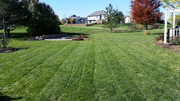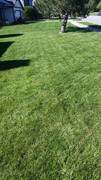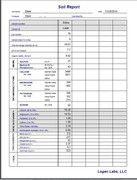
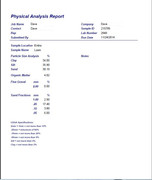
We moved to this house in July of 2012, during The Drought of the Century. The lawn looked horrible, but then again, so did the lawns of virtually every other home we looked at then. The back yard was horrible, and the front was almost as bad. The first two pictures below
Back Yard: August, 2012
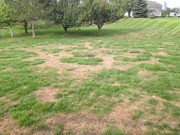
Front Yard: August, 2012
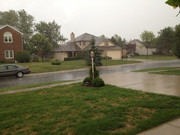
were taken a couple of weeks after we moved in; you can almost feel my giddiness when you look at the picture of the thunderstorm--our first rain at the new house! I had high hopes that the lawn would come back once the rains started, and it was a fairly normal Fall wrt rain. The front partially recovered, the back, almost not at all. I also noticed the mycellium of (pick the fungus) on my lawn, visible in the morning dew. The landscaper called it pythium blight, which it well may have been. In any case, I was left with a dead back yard. If I had been on this site by then, you would have thought that it would have been a perfect nothing-to-lose reno opportunity. But not so fast.
I had a contractor aerate the whole lawn, spread 8 yards of compost, and seed. The irrigation installers chopped up some of it, but they also reseeded and I was not concerned at that time. Meanwhile, the rains started, and it didn't take long to realize that I had a flooding problem. As little as 0.2" of rain resulted in standing water that took days to drain. The landscaper who installed our fire pit pointed out how my yard was bowl-shaped, with the house and back property lines a good 10" higher than the lowest point. We also were not connected to any drainage, but that is another issue. He brougnt in 4 yards of top soil, and at least raised the left side of the lawn, from the point of view of the third picture--I called that my flood plain. He then seeded. Here is what the back looked like two days after a light rain/snow mix:
Back Yard: December, 2012
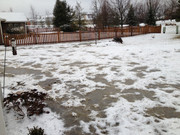
That helped some, but we still had issues. The next spring (2013), I had the City of Fort Wayne come by. Too bad, so sad, they cannot do anything on private property--that is my problem. One of the inspectors took me aside and said that he could take care of my problem outside of work. We agreed on a price and scope of work. Yard dug up again, drains and tile installed, leading through my kind neighbor's yard, and on to the drainage beehive which then leads to a subdivision pond. This has helped immensely, and most of my standing water problems have been solved. The entire back yard is still mushy after rains/irrigation, but orders of magnitude better than it was. I'll have to deal with the same problem on one side yard, but I cannot afford any more large monetary outlays on the lawn, at least for a while. Oh, as a result of all of these activities, I should now have about 6" of top soil on parts of the Flood Plain, which is sitting on top of an inch of compost.
My lawn is now about 6500 square feet, as paced off by me and corroborated by my daughter.
I normally mulch cut the lawn, and this year have taken to taking neighbors' leaves to mulch in as well. Up until this fall, I have been a Scotts 4-Step guy. Since I have the irrigation system, I do not let my lawn go dormant, and have always adhered to the occasional deep watering idea, although it is tough with running off because of my rather impermeable soil. I have done 3 applications of Best Lawn Soil Conditioner as well as Kelp Help and Humates, also 12 bags in two applications of Encap Lawn and Garden Compost. Dropped the urea earlier this week, once top growth had stopped. (First time ever for that.) Before submitting this soil sample to Logan Labs I performed a soil structure test, as described here:
http://aroundtheyard.com/home1/articles ... ement.html
Although the results showed a very low percentage of clay (although, obviously, the official analysis tells a different story!), it is severely compacted, as indicated by my percolation results--less than 1/4" an hour. . Another interesting point is that, when taking cores for soil analysis, I noticed some gravel (in th"- 3/8" size range) scattered about 3" below the surface, in the front yard only. I found this interesting, since the front yard does drain better than the back.
My goals are pretty modest at this time. I am toying with the idea of a renovation, but if I do, it would have to be the front and one side only, at least until my drainage issues are resolved in the back and other side yard. I would like to have a lawn that turns heads and, more importantly, makes me smile. But even those low-bar goals would be achievable, given the lack of nice lawns in my immediate neighborhood. Eventually, yes, I would like a showplace lawn, front and back. I am open to (OK, wishing for) expert opinions to the contrary, but I think that I should address my soil deficiencies before I undertake a reno. Maybe 2-3 years? I've exceeded the maximum number if images, so I will post the pictures of what the lawn looked like in October in another post.
Thanks to you all for your help and advice.
Dave
